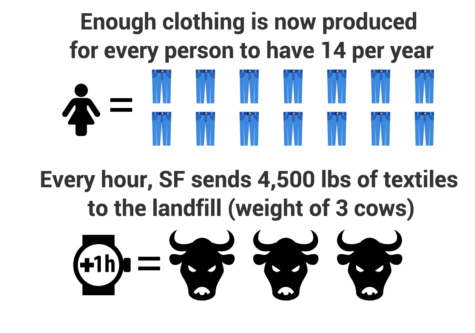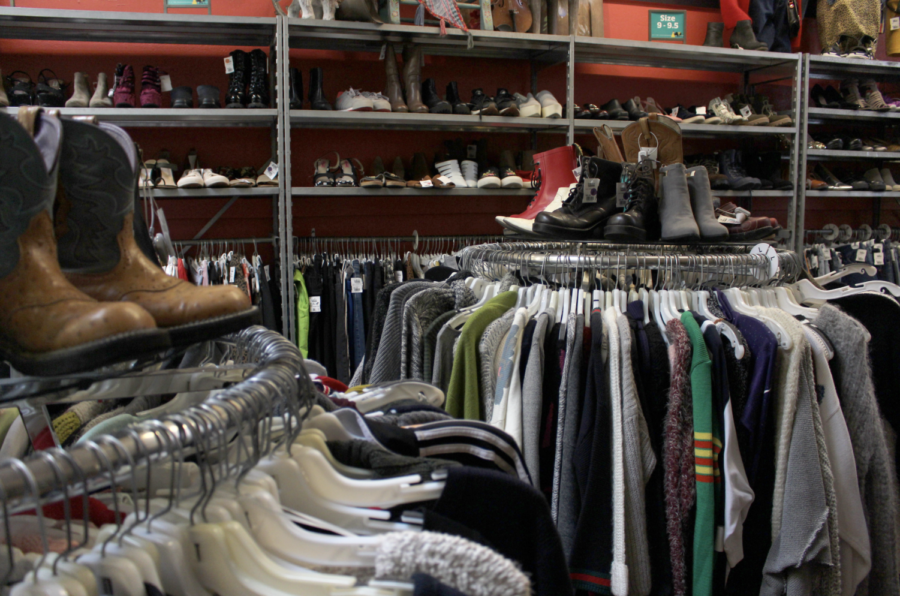Green is the new black: thrifting could be the answer to fast fashion pollution
Interior of a thrift store on Haight street. By Ellie Lerner, staff writer.
This December, the Urban school Green Team hosted a school clothing swap in which Urban students donated clothes and were able to choose items to add to their wardrobe from one another’s donations. “The goal,” said Elsie Lipson ‘20, the leader of the clothing swap on Green Team, “[was] to bring awareness to the impact of our buying habits.”
Shopping for clothing has become more harmful with each new fashion micro-season. In a Huffington Post article, Kara Hackett reported that Americans are “buying 400 percent more clothes than we bought just 20 years ago.” Based on the calculations of the World Resources Institute, the average American consumer is purchasing 60 percent more articles of clothing each year while using each garment only half as long.
The increase in the consumption of clothing garments has followed the escalation of fabric production. According to the 2016 “Sustainability & Resource Productivity” report released by the McKinsey & Company, “The number of garments produced annually has doubled since 2000 and exceeded 100 billion for the first time in 2014: nearly 14 items of clothing for every person on earth.”
Driven by the cheap prices of mass-produced fashion and short-lived fashion fads, people are not only buying but also throwing away more clothes than ever before. According to the Ellen MacArthur Foundation, one garbage truck of textiles is wasted every second. In San Francisco alone, the San Francisco Department of the Environment reports that 4,500 pounds of textiles are sent to the landfill every hour by city residents.
The impact of the fast fashion cycle does not end with the inordinate amount of waste generated by overconsumption; much of the environmental impact of our clothes takes place on the production level. An article in Independent Magazine explained that with growing clothing demand, “textile dyeing [has become] the second largest polluter of clean water globally.” In addition to textile dying, the production of non-organic cotton uses strong pesticides that contribute to chemical pollution in water and soil while polyesters produce small, plastic microfibers that end up in waterways and the ocean food chain.
The overconsumption and over-production of clothes in recent years has sparked environmental concern, leading some consumers to become more aware of the impact of their buying habits. Bell Davis ‘19 said that she finds “fast fashion really disturbing, both from a humanitarian perspective and an environmental perspective, and I think that it’s a larger reflection of how so many people look at our time on earth on a day by day basis and don’t really think about the long term impact of their choices.”
The clothing swap at Urban also coincided with a push in San Francisco to address the environmental impact of textile waste. In 2014, San Francisco was the first city to implement a textile recycling program. By placing textiles on top of recycling bins, residents are able to recycle their used or unwanted clothing items.
While the recycling of discarded textiles into new materials has become increasingly popular as a solution to textile waste, many environmental organizations have opposed this model. Greenpeace, a global environmental non-profit, explained that “behind this nice phrase lies the industry’s fantasy that circularity can fix a material-intensive system.” Unfortunately, the technology for recycling fabrics is not developed to the point that old clothes can be 100% recycled into new fabric and even with partial recyclability, the process releases carbon dioxide into the air and contributes to global warming. A report released by Greenpeace warned that the circular fashion model also protects the profits of the fast fashion industry since “the overconsumption of textiles is the larger problem that must be tackled. In addition, the promotion of the circularity myth that clothes could be ‘infinitely recycled’ may even be increasing guilt-free consumption.”
Alternatively, thrift shops, resale stores, and clothing swaps help combat both the overproduction and overconsumption of clothing. As articulated by Eloise Brotzman ‘21, San Franciscans are beginning to realize that “there are really three options when you want to buy to new clothes. One is that you go to a big brand like H and M or Forever Twentyone where it’s cheap and mass produced but also really bad for the environment. The second option is to go to a boutique clothing shop that is not as bad for the environment but also really expensive. The third option is thrifting which is a blend of the two other options since its both environmentally friendly and cheap; thrift stores really are the perfect solution.”
This past year, San Francisco Lowell High School also hosted a clothing swap in which 500 articles of clothing were donated and swapped by students. Kristen Tam, a senior at Lowell who organized the clothing swap, said that the school’s environmental club was “inspired by the increasing number of students thrifting nowadays and we wanted to share that with everyone in the school community. I think it helped break the stigma around wearing used clothes because it was in a school environment and so people felt more comfortable wearing clothes from people that they actually knew.”
Tara Kamali ‘19, who says she thrifts almost every weekend, explained that thrifting has become a popular trend among Urban students: “There will be times when I’ll see something at a thrift store then come into school the next day and see someone else wearing it. I think that since Urban has a lot more affluent families, the appeal of thrifting is not so much the cheap prices but more that vintage is trendy.”
Urban’s Green Team successfully capitalized on this popular trend, hosting a clothing swap in which students traded 100 items of clothing. Lipson explained that “because the clothing swap went so well, [Green Team is] going to try to do one every term.” By using purchasing power to descale clothing production levels, Lipson concludes that “we can put pressure on these [clothing] companies to think a little bit more sustainably.”

Infographic of various statistics related to textile production and waste.


